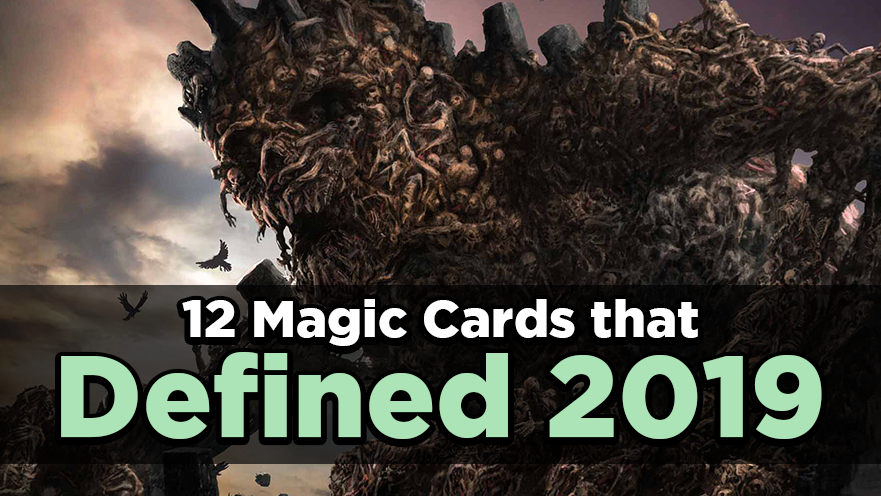2019 has been a massive year, in Magic and in general. So much happens with such intensity that it can be tough to put ourselves in the mindset of even a few months ago! So as we turn the final page on our calendars, let’s reflect on 2019 and count down the cards that defined the year in Magic.
JANUARY: Arclight Phoenix (Guilds of Ravnica)
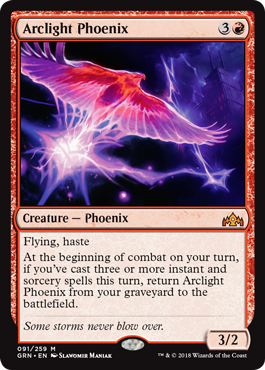
The most important trend of 2019 by far is how the volume of online conversation around Magic has transformed the player experience. Where once things like card evaluations were a process of discovery at your own pace, they are now blasted at you like water from a firehose.
But the internet hivemind gets it wrong sometimes, as we did during Guilds of Ravnica spoiler season. After going for a buck or two on release, Arclight Phoenix rose from the ashes of the bulk rare pile to Top 8 events in Standard, Modern and Legacy. Whether the assist came from Chart a Course or Buried Alive, the consistent threat of 6 to 9 hasty power in the air early led to a value spike that rewarded those brave enough to back their own high opinions of this awesome thunderbird.
FEBRUARY: Pteramander (Ravnica Allegiance)
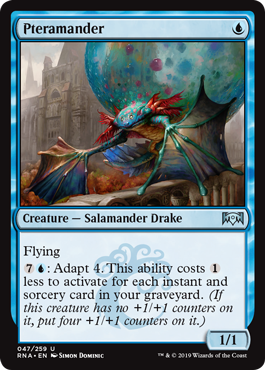
While not quite the “new Delver,” Pteramander did briefly have a cross-format Constructed impact, enabling blue spells decks with impressive efficiency. But Scary Pterry shined brightest in Standard, with R&D re-debuting blue tempo as an evergreen archetype.
By far the best blue tempo deck of the year was Autumn Burchett’s winning deck from Mythic Championship I. Autumn’s groundbreaking win set the tone for a higher focus on social issues in the Magic community, and Pteramander became an unlikely mascot for trans rights.
MARCH: Ill-Gotten Inheritance (Ravnica Allegiance)
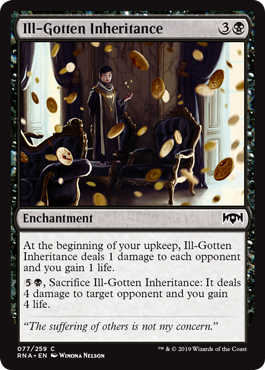
Ravnica Allegiance was acknowledged as a terrific draft set, and among the first that many players experienced through Magic Arena. Ill-Gotten Inheritance was an unassuming common which, in the past, would likely have been slept on by most people.
But thanks to the hive-mind of the internet, players had singled out Inheritance as a key card in the format within just two days. It was an all-star finisher in aggressive black decks and a splashed-for win-con in defensive Azorius.
As a common, there were multiple Inheritances in most draft pools, and the Arena drafting AI didn’t know how to prioritize them. This made it trivial to get as many as you’d like! Other commons would continue to dominate the Arena draft meta as the year went on (most notably Heart-Piercer Bow and Merfolk Secretkeeper); meeting the demand for more balanced drafting will no doubt be one of the most important challenges for Arena next year.
APRIL: Smothering Tithe (Ravnica Allegiance)
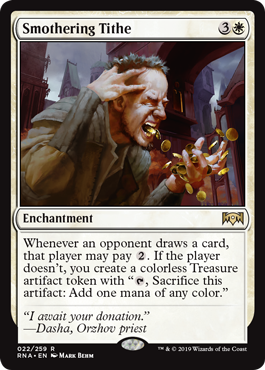
This card might seem surprising to find on the list — if you don’t play much Commander, that is. Wizards have been providing more treats for the dominant casual format in each new Standard set, and Smothering Tithe was immediately spotted in CK’s own Commander set review.
Smothering Tithe is already in over 20% of all white Commander decks according to EDHREC. In decks created more recently, it’s at 36% inclusion — the 2nd most popular white card, behind Swords to Plowshares. It also signified a push by Wizards to help white’s color pie issues in eternal formats, which was confirmed when Charming Prince and Happily Ever After were spoiled for Eldraine.
MAY: Narset, Parter of Veils (War of the Spark)
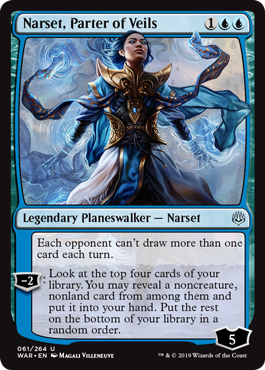
The design choices made around 3-CMC Planeswalkers have been perhaps THE hot-button issue of 2019, but I already wrote an article about that! Suffice it to say that Narset, despite not ticking up, embodies a lot of the excesses we’ve seen from the card type.
Narset immediately generates card advantage on resolution, disincentivizing players from spending resources to kill her. However, she generates further advantage if left in play — many decks cannot even operate under her brutal static ability. In Vintage especially, her “prison” effect devastated the meta until she was finally restricted last month.
JUNE: Hogaak, Arisen Necropolis (Modern Horizons)
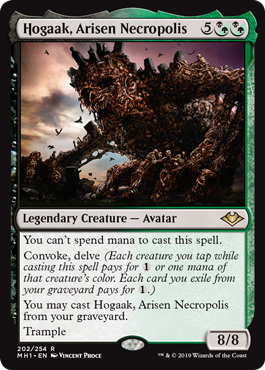
In a less tumultuous Magic year, the Gaak would easily be the #1 definitive card. It was a standard-bearer for Modern Horizons, itself a huge step forward in how Wizards curates the card pools of Constructed formats. The supremely pushed design highlighted the difficulty of trying to seed new archetypes into a volatile Modern metagame without completely breaking it.
Also, Hogaak won an absolute boatload of tournaments during its short few months of unlife. Several other cards were banned from Modern between June and August in attempts to stall its rampage, but in the end, Hogaak itself had to go.
JULY: Veil of Summer (M20)
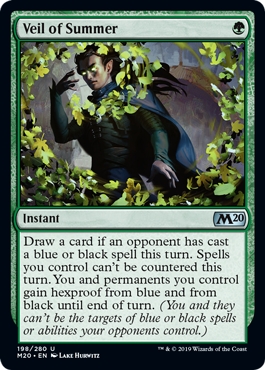
Splashy bombs like Hogaak will always be the first cards to draw attention when they break. But Magic is as much about small exchanges of resources and information as it is about the cards that actually end the game. And when those small exchanges are really pushed, they can be just as impactful!
Following in the footsteps of Gitaxian Probe, Ponder, and Mental Misstep, Veil of Summer added an uncharacteristic level of stack interaction to already-dominant green decks in Standard. While it has now been banned there (and in Pioneer, too), the Veil still holds power in eternal formats. There, its automatic 2-for-1 exchange is even better than the “Green Elemental Blast” nickname would suggest.
AUGUST: Kethis, the Hidden Hand (M20)
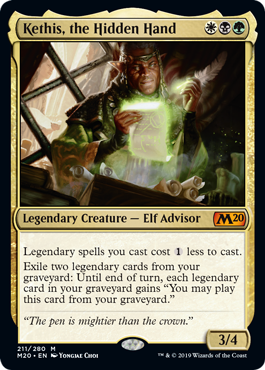
The increased pace of online discussion about Magic has also sped up the development of new Constructed decks. With so many great Magic minds collaborating to “break” formats, we sometimes start to wonder if brewing is no longer worth it.
Stan Cifka and Ondrej Strasky reminded us all that is not the case in August, when they unveiled a new deck in Standard just before rotation. The powerful Kethis Mill combo deck had been hiding in plain sight for months, disregarded and untouched. Kethis + Mox Amber is such a strong engine that it will likely resurface at some point in non-rotating formats, reminding us there’s always new deckbuilding gold to mine for.
SEPTEMBER: Arcum’s Astrolabe (Modern Horizons)
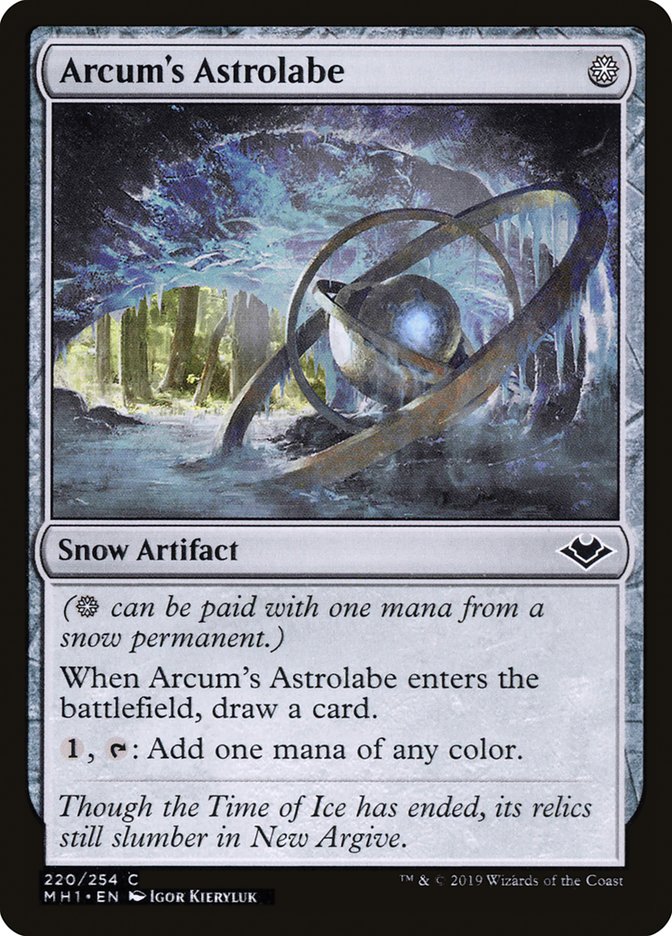
Astrolabe is a calculated attempt to cross a big line in Magic design and see who notices. Essentially a free inclusion in decks with snow lands, it generates a resource advantage while trivializing colored mana costs. Magic already wrestles with keeping multicolor decks in check in older formats, and Astrolabe bypasses the giant hammers of Blood Moon and Back to Basics that previously held those decks back.
The homogenizing effect of Astrolabe led to its banning in Pauper after months of increasing dominance, but its weight is now being felt in Legacy, Vintage, and Modern. While it was a boon for Modern Horizons drafters, Astrolabe collapses deck variety in Constructed and rewards players for using snow lands instead of their favorite basics.
OCTOBER: Embercleave (Throne of Eldraine)
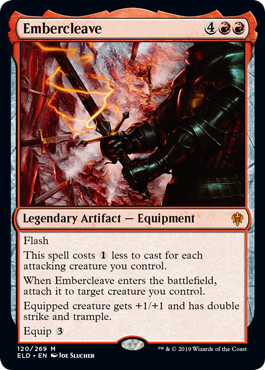
Like the card itself, my reasons for including Embercleave here are straightforward, and very powerful. One, the mythic rare equipment was the key tool that helped Javier Dominguez to victory at MCV. Two, the ability to play the world’s biggest combat trick was the only thing keeping aggro decks alive in the September-October meta of Oko and Golos Field. Thanks, Embercleave.
NOVEMBER: Oko, Thief of Crowns (Throne of Eldraine)
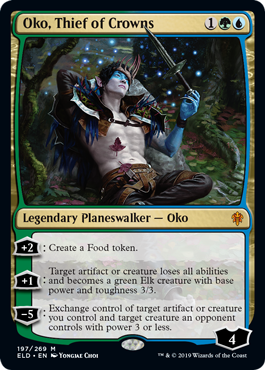
If you thought you would get through this list without seeing this guy, you’re as tragically optimistic as the 31% of players who failed to register Oko at Mythic Championship VI last month. In every format, every discussion about Magic’s direction and design — even in memes! — Oko is inescapable. (“In-elk-scapable”?)
Many, many words were written about Oko in Standard before he was mercifully put to the sword, but I want to stop a moment and highlight his total dominance across all of Magic. In addition to being banned in Brawl and likely the biggest bomb of his Limited format, the elk-master is featured prominently in Pioneer and Modern. Unrelated decks that play even one of Oko’s colors have been measurably improved just by jamming him in the 75. He took both Vintage and Legacy honors at Eternal Weekend, reducing the iconic Power 9 to so many expensive 3/3s. Oko was indeed broke-o.
DECEMBER: Field of the Dead (M20)
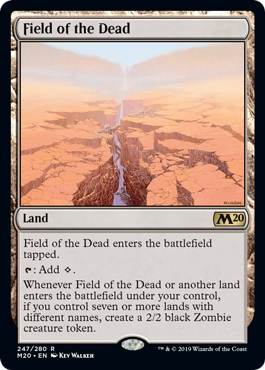
Since its release this summer, Field of the Dead has served as a huge reminder that inevitability and land-based strategies are just plain good. Field entered Standard as a late treat for fans of Scapeshift, but then did so well without it that WotC had to resort to a ban. This is emblematic of a year-long trend of more frequent bans as R&D continues to push powerful designs through Standard.
Field currently sees play in nearly every format, although its presence in eternal formats has a different character. Adding an extra dimension to Amulet Titan or Legacy Lands feels a lot more forgivable than the oppressive ramp strategies built around it in Standard and Pioneer.
Of all the cards on the list, Field of the Dead looks the most likely to continue on and help define 2020, for better or worse. If R&D continues to aggressively push the power level of Standard cards, we will have to get used to seeing some banned every couple of months. But we may also benefit from meta shake-ups and increased accessibility in older formats as the new staples make their mark there. There’s to be no turning back from our explosive year in Magic — only staying aware of the change and trying to make the most of every part!

Tom’s fate was sealed in 7th grade when his friend lent him a pile of commons to play Magic. He quickly picked up Boros and Orzhov decks in Ravnica block and has remained a staunch white magician ever since. A fan of all Constructed formats, he enjoys studying the history of the tournament meta. He specializes in midrange decks, especially Death & Taxes and Martyr Proc. One day, he swears he will win an MCQ with Evershrike. Ask him how at @AWanderingBard, or watch him stream Magic at twitch.tv/TheWanderingBard.

